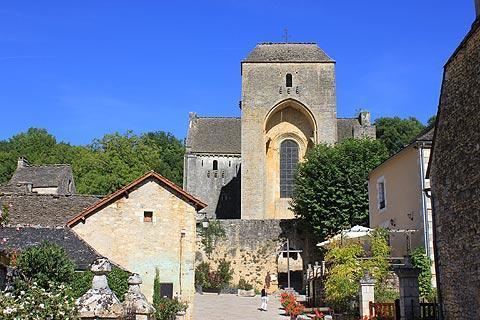Intercommunality Vallée de la Vézère Area 26.4 km² Local time Tuesday 4:40 PM | Canton Montignac Time zone CET (UTC+1) Population 356 (1999) | |
 | ||
Weather 19°C, Wind W at 6 km/h, 45% Humidity | ||
Saint-Amand-de-Coly is a commune in the Dordogne department in Nouvelle-Aquitaine in southwestern France.
Contents
- Map of 24290 Saint Amand de Coly France
- Geography
- History
- Origin of the Town Name
- Administrative Structure
- Sites Monuments
- People linked to the town
- Local Life
- References
Map of 24290 Saint-Amand-de-Coly, France
The village is a member of the Les Plus Beaux Villages de France ("The most beautiful villages of France") association.
Geography
In the heart of the Dordogne, the town of Saint-Amand-de-Coly is crossed from south to north-east by Chironde, a thin tributary of Coly and sub-tributary of the Vézère.
The village is located eight kilometers east of Montignac, both southwest of Terrasson-Lavilledieu and 19 kilometers north of Sarlat-la-Caneda, away from main roads.
In the Middle Ages, Saint-Amand-de-Coly guarded the source of the Coly, until it fell.
The town is served by 64 county roads (southeast) and 704 (formerly 704 national road in the southwest).
History
The town has several places traces of prehistoric human occupation, inn addition to Gallo-Roman.
Although the Augustinian abbey was built in the twelfth century, the first known written mention of the place dates back to the fourteenth century in the Latin form Amandus prope Montinhacum Sanctus ("Saint Amand near Montignac").
The town, during the revolutionary period of the National Convention (1792-1795), was named Amand-le-Vallon.
Origin of the Town Name
The name of the town refers to St. Amand, hermit came to evangelize the region in the sixth century including near the village of Coly, where the abbots had a castle verified in 1406 (Castrum de Coly).
In Occitan, the town is named Sench Amand coli.
Administrative Structure
The city of Saint-Amand-de-Coly, as early as 1790, was part of the canton of Cassagne which was part of District Montignac until 1795, the date districts were dissolved. When this district was dissolved by the law of 8 pluviôse year IX (28 January 1801) on "reducing the number of justices of the peace," the district was made part of the township of Montignac, which was part of the district of Sarlat (now the district of Sarlat-la-Caneda since 1965).
At the end of 2001, all of the communes of the Vézère Valley were made part of Saint-Amand-de-Coly. It was dissolved on 31 December 2013 and replaced on 1 January 2014 by the community of cities of the Valley of Man.
Sites & Monuments
People linked to the town
Local Life
The village festival is held every year on August 15, with Mass of Saint-Hubert sounded by hunting horns, with meals of Périgord specialties, dancing, entertainment and more.
In July and August there is a farmer's market in the tobacco barn. Every Tuesday from 17:30, producers offer their products (meat, canned fruits and vegetables, wines, cheeses, cakes, and more).
In August, the abbey hosts several classical music concerts and master classes early music, as part of the Festival de Périgord Noir.
